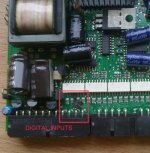kallileo
Lifetime Supporting Member
There is a milk cooling tank where a conductive electrode used as water level switch is connected to a PLC Digital Input.
The electrode grounds the PLC input when the water level reaches the electrode to activate the water circulation pump.
The problem is that having the PLC input grounded to the metal body of the tank doesn't seem like a good idea to me.
I have seen in many cases some SMDs located on the PCB near the DI where destroyed.
The design of this system has a flaw.
I believe the source of problem is this electrode and the grounding damages the DI.
Is correct to use this electrode this way?
I have attached photo of the electrode.

The electrode grounds the PLC input when the water level reaches the electrode to activate the water circulation pump.
The problem is that having the PLC input grounded to the metal body of the tank doesn't seem like a good idea to me.
I have seen in many cases some SMDs located on the PCB near the DI where destroyed.
The design of this system has a flaw.
I believe the source of problem is this electrode and the grounding damages the DI.
Is correct to use this electrode this way?
I have attached photo of the electrode.

Last edited:








